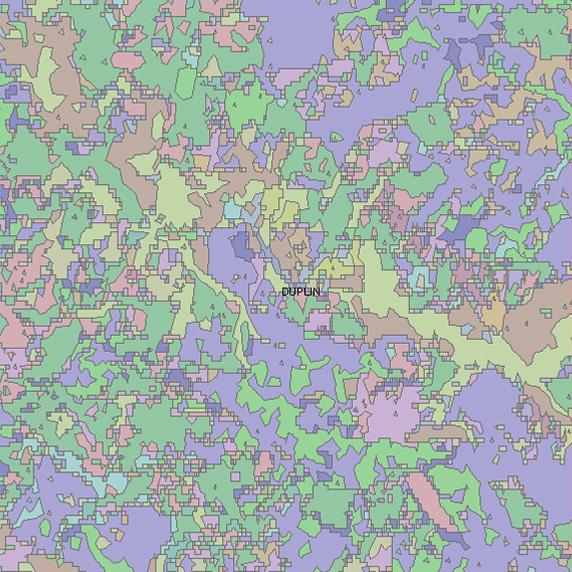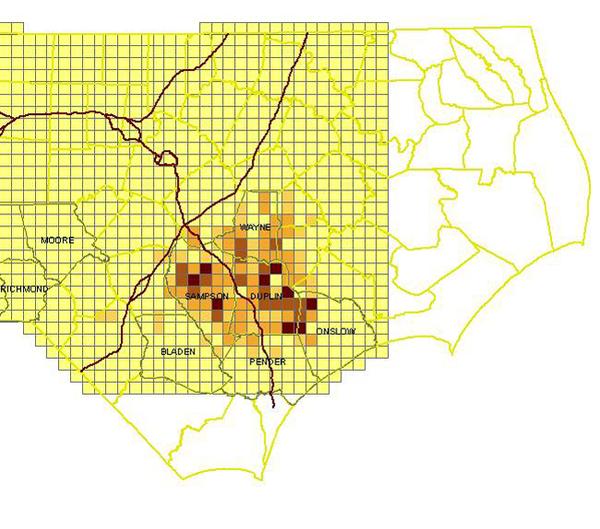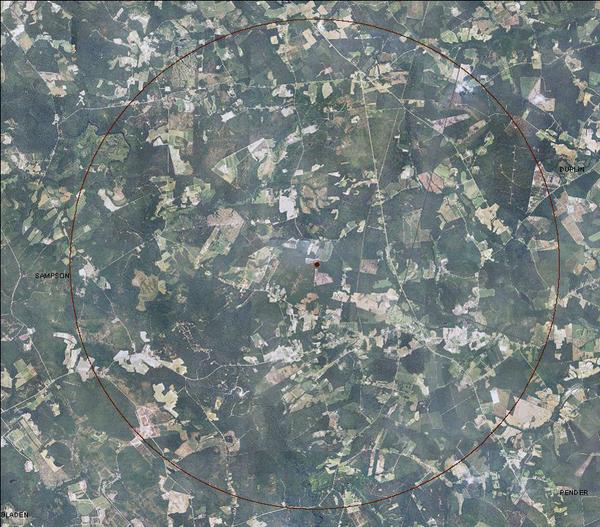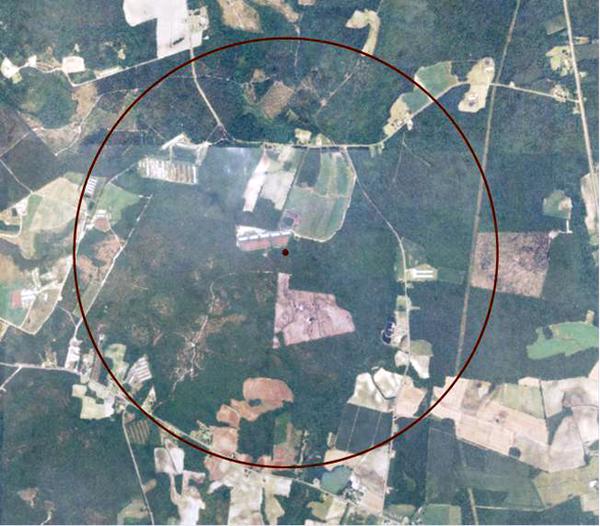Background
Applying poultry manure to forestland that needs nitrogen and phosphorus can help poultry producers manage waste and put valuable nutrients to work for forest owners.
Forest soils in the southern United States are almost universally deficient in nitrogen (N) and phosphorus (P). These forests often exist near animal feeding operations that produce large surpluses of N and P in animal manure (Figure 1). North Carolina has 30 counties where more P is produced in animal manures than can be assimilated by all the cropland and pastureland in those counties, and 7 counties where more N is produced than can be assimilated (Gollehon et al., 2001). These analyses did not consider forestland. It appears that forestland will have to be used – in addition to available cropland and pastureland – if land application is to continue to be a method by which North Carolina poultry producers manage animal waste nutrients and retain their prominent position in U.S. animal agriculture. Thus, great potential exists to develop mutually beneficial “win-win alliances” between poultry producers and forest owners by putting the valuable N and P nutrients in poultry manure to work in forests. Research shows that fertilization can increase production of a wide variety of marketable forest products and enhance ecosystem services. Shorter-rotation forest crops, such as nursery planting stock or woody biomass species, and annual crops such as pinestraw can also benefit when pine forests are fertilized.
This publication is based on a research project designed to investigate factors that make forest fertilization with animal manures successful in North Carolina. We investigated the practical experience and perspectives of animal producers, forest owners, and forest managers through interviews with poultry producers who have used or considered using poultry litter to fertilize forests. Sometimes the poultry producers we interviewed also owned or managed the forestlands where poultry litter nutrients were being applied to increase yields of marketable forest products.
North Carolina has about 17 million acres of forestland (58 percent of the state’s total land area), almost 90 percent of which is privately owned. That includes about 2 million acres of loblolly, slash, shortleaf, and longleaf pine plantations, about 100,000 acres of which are fertilized with synthetic chemical fertilizers or animal manure nutrients. Plantations of hardwood trees are much less common in North Carolina and comprise about 10,000 acres with essentially no routine fertilization.
Southern pine plantations were the most common type of forest currently being fertilized with poultry waste by our interviewees. The amounts of poultry manure nutrients being applied usually involved applications of moderate amounts of dry poultry litter (typically containing 30 to 40 pounds of N per year).
Nearly 3,000 poultry farms are located in the North Carolina piedmont and coastal plain, producing turkeys, chicken broilers, and eggs. Farms that produce eggs often use a liquid waste management system; they represent a relatively small fraction of North Carolina’s poultry sector and are not considered here. Agriculture statistics indicate that about 760 million broilers and 35.5 million turkeys were produced in 2009. The total amount of poultry manure (wet plus dry excretions) produced in North Carolina is estimated to be 8 to 10 million tons per year. As shown in Figure 2A, turkey production is concentrated in the North Carolina southern coastal plain; Figure 2B shows that chicken production is distributed across the North Carolina coastal plain and southern piedmont.
Based on 1996 to 2006 analyses, poultry litter in North Carolina has average plant-available nutrients per ton of about 29 lb N, 26.8 lb P2O5, and 40 lb K2O for broiler house litter and 24.2 lb N, 28 lb P2O5, and 26.6 lb K2O for turkey house litter (Cleveland et al., 2007).
Farms with 30,000 or more birds must develop poultry dry litter management plans but are not required to obtain general manure application permits. Poultry manure waste management plans are designed to maximize beneficial use of manure nutrients and minimize nutrient losses from the farm. Appropriate manure application rates for both agricultural crops and forest trees are determined by realistic yield expectations (RYE) for the specific crop, soil characteristics of the specific site, and the nutrient content of the poultry litter.
Benefits of Using Poultry Litter in Forest Fertilization
Using poultry litter in forest fertilization offers benefits to poultry producers and forestland owners. The quotes noted below came from the poultry producers we interviewed.
- Offers additional land for useful nutrient application. Alliances between poultry producers and forest owners and managers can provide additional land for fertilization applications. One interviewee noted that, “This advantage is likely to become more important in the future especially if P requirements become more of an issue.”
- Allows a longer window of time during the year for application. Forests can have nutrients applied to them during periods when some pasture or row crops can’t be fertilized; the application window for pine stands usually extends from February through November.
- Provides an alternative to fully clearing a site for pasture or row crops if establishing a new application site. “A real benefit of this practice is that bulldozing a lane through an existing forest site will quickly get you 6 to 7 acres to apply to, instead of needing to clear the whole area for grass.”
- Avoids the expense of yearly harvests of annual crops. “If the trees will take it [the nutrients in poultry litter], you won’t have the expense of harvesting the hay or rye crop.”
- Increases growth of a valuable crop. Most southern pine plantations are limited by nutrient availability. Long-term research by the Forest Nutrition Cooperative (formed by NC State University, Virginia Polytechnic Institute, and Universidad de Concepción in Chile) indicates that most southern pine stands throughout the southern states show strong growth in response to fertilization with N and P. A typical wood volume growth increase is 30 percent over 8 years and can be as high as 100 percent (Fox et al., 2007). Four recent studies have documented 25 to 40 percent and up to 50 percent increases in annual production of longleaf pinestraw after fertilization with either poultry litter or synthetic N and P fertilizers (Blevins, 1994; Blevins et al., 1996; Environmental Impact, 2003; Allen, 2007).
Addressing Obstacles to Using Poultry Manure Nutrients in Forest Fertilization
During interviews with poultry producers, several perceived obstacles to the use of manure to fertilize forestlands were identified and potential ways to overcome them were discussed.
Concern about delivering animal manures into forest stands. In general, forest fertilization systems have successfully utilized the same application methods and spreader equipment traditionally used on agricultural crops. Ideally, a forest stand is planted at a spacing that will allow the equipment required to spread litter to pass through the stand. Thinning to remove rows at an interval, such as every fifth row, in a stand previously established at a smaller spacing, or clearing lanes in naturally regenerated stands, are also used as ways to provide access over a whole stand rotation.
Lower rate of nutrient application than pasture or row crops. The Natural Resources Conservation Service (NRCS) nutrient application rate guidelines for forests are lower on an annual basis than guidelines for most agricultural crops, though the revised guidelines allow a relatively large rate (300 lb N/acre) to be applied every fifth year. Sufficient forestland should be identified to ensure appropriate application rates based on the poultry litter’s nutrient content, either as an adjunct to pasture and cropland or as a primary application site. Most forest soils have not been subjected to repeated nutrient applications, as is the case with many agricultural soils, and so tend not to have accumulated P. NC State University and local Cooperative Extension agents in your county can assist with fertilizer recommendations.
Logistical and operational issues. Some interviewees raised this concern: how to coordinate the timing of poultry house cleanout with timing of forest fertilization. Maintaining storage areas for poultry litter, either on individual farms, within forests, or in centralized regional locations, is a potential solution to this problem. Because manures are low nutrient analysis materials, hauling distance can become a critical issue. Coordination of manure volumes and available forest sites is necessary to successful application contractors.
Wood and needle quality. The forest owners we interviewed were concerned that rapid tree growth induced by fertilization would cause reduced wood quality. Recent studies indicate that N added in moderate amounts (100 to 200 lb/acre) to southern pines increased growth for 3 to 5 years and did not significantly change wood strength or stiffness (Clark et al., 2004). Some evidence supports better wood quality from balanced nutrient sources compared to typical urea and diammonium phosphate fertilizers. Some longleaf pine producers believe that high fertilization rates cause growth of exceptionally long longleaf needles that decay quickly. Longleaf pine is particularly sensitive to high fertilization rates. Excessive fertilization can increase needle length and thus make stands more susceptible to ice breakage, pitch canker, and insect attack. It is important to use fertilization rates recommended for specific tree stands. NC State University and local Cooperative Extension agents in your county can assist with fertilizer recommendations.
Weed production. Several longleaf pinestraw producers saw an increase in weeds as an obstacle to manure application. Fertilization with any nutrient source can cause increased growth of undesirable as well as desirable species. Problems with weed production can be minimized with timing of fertilization application relative to pinestraw raking and with herbicide treatments.
Disease transmission to wildlife. The forest owners we interviewed expressed concern about the potential threat of disease to wild turkeys exposed to domestic poultry litter applied in forests. This seems to be a common worry. Anecdotal evidence exists of wild turkeys contracting diseases from domestic birds confined nearby, but we found no published evidence of disease transmission to natural wild turkey populations as a result of exposure to domestic poultry litter.
Official Guidelines for Land Application of Manure in Forest Stands
The NRCS Nutrient Management Standard (Code 590) and Waste Utilization Standard (Code 633) provide technical guidelines for manure application to forest plantations in addition to croplands (see the NRCS Field Office Technical Guide). According to these NRCS standards for North Carolina, which are based in large part on guidelines provided by the NC Interagency Nutrient Management Committee, up to 60 lb of plant available nitrogen (PAN) per acre per year is allowed for application on pine forestland, except for longleaf pine stands where 30 lb PAN/acre/year is the recommended limit. On hardwood forest stands suitable for organic fertilizers, application rates should not exceed 80 lb PAN/acre/year. Higher N application rates on forestland may be approved in situations where concentrated single waste applications may be necessary, or in cases designed to meet a specific forest nutrition prescription in an approved forest management plan. As a general prescription for waste application on forest plantations, when land receiving waste is predominantly pine forest, organic fertilization must be part of a forestry management plan developed by a qualified professional. Also, animal operations with North Carolina and Nonpoint Discharge Elimination System (NPDES) permits must include all areas where waste is applied in a certified animal waste management plan.
In cases where concentrated single applications are needed, the total application rate can be as high as 300 lb N/acre. Such single applications should not be repeated more frequently than every fifth year, or every tenth year in the case of longleaf pine, in order not to exceed recommended average annual N application rates. Annual soil tests, taken at a soil-surface-to-6-inch sampling depth, must be completed in pine forest application areas to help determine the potential for P leaching. If soil test agronomic P indices are above 50, then no additional animal manure waste application should occur on forestland. A phosphorous loss assessment (PLAT) is not needed for forestland receiving animal manures.
Negative impacts on streams, wetlands, and riparian buffers must be avoided when applying animal manures, and appropriate application setbacks must be observed. At a minimum, no waste material should be applied:
- In wetlands and in poorly drained or organic soils
- Within 100 feet of a well
- Within 200 feet of a dwelling other than those owned by the producer
- Within 75 feet of a residential property boundary
- Within 75 feet of an intermittent, seasonal, or perennial stream or river other than an irrigation ditch or canal
North Carolina and NPDES permitted animal feeding operations are required to observe setbacks set forth by their respective permits and North Carolina regulatory requirements.
Some native plants adapted to low fertility sites are able to compete with introduced species because of limited forestland fertility. Application of organic materials may increase the potential for introducing invasive plants, enhancing their viability, or both. Because the effects of increased fertility in native plant understory are not well understood, any application of waste materials in forestland where the health of native plant communities is a resource concern should be closely monitored for negative impacts. Any increase in noxious or invasive plant species in communities should be noted and considered when fertilizing trees with animal waste materials.
Description of a Useful GIS Database
An important part of our research project with forest owners and swine and poultry producers was development of a geographic information system (GIS) database that contains general information for much of the state and more detailed information for the following nine North Carolina counties: Bladen, Duplin, Moore, Montgomery, Onslow, Pender, Richmond, Sampson, and Wayne. The database incorporates the following information: swine operations (2003); 5-mile grid of poultry farms (2007); highways, streets, municipalities, county boundaries, major water bodies, major streams, and river basins for North Carolina; detailed water bodies for the Cape Fear, Lumber, Neuse, White Oak, and Yadkin River Basins; land use/land cover classes; and parcels, soils, and aerial photography (2007) for the nine study counties.
Figure 3 provides examples of products from the database. Figure 3A indicates the parcels of land within a 5-mile radius of a swine finishing farm (the circle is centered on the farm parcel), that fall into two land cover categories: coniferous cultivated plantation or coniferous regeneration. This represents more than 11,500 acres; a similar calculation for a 1-mile radius (Figure 3B) yields more than 500 acres. Information about poultry operations is only available as gridded population density, but similar calculations can be made if specific location information is provided by a poultry farm owner. Calculations can be made for different forest cover types and different radii. Land parcel ownership information is available to assist in connecting landowners. Similar information can be found by contacting local offices of your county tax assessor, N.C. Cooperative Extension, NC Forest Service, USDA Farm Service Agency, or Natural Resource Conservation Service.
Economics
The economics of transferring poultry litter to forest stands is similar to that for agricultural crops. In many cases, poultry producers are also forest owners, and thus have associated land that is forested and can be used for manure application. In some cases, poultry producers lease land for waste application to trees. Alliances between producers of nutrients (animal producers) and potential receivers of nutrients (other landowners) are usually developed by personal contact. If a farmer wants to convert existing cropland to trees or is seeking help with transportation costs of animal manures, several incentive programs exist that may provide cost-sharing:
NC Agricultural Cost Share Program (NCACSP)
The Agriculture Cost Share Program for Nonpoint Source Pollution Control uses legislative funds administered by the Soil and Water Conservation Commission to assist farmers in best management practices that reduce the input of agricultural nonpoint source pollution into North Carolina waters. The program currently includes 33 counties and can provide up to 75 percent of the cost of a practice up to a maximum of $75,000 per year. Some practices that qualify for assistance include cropland conversion to permanent vegetation, closure of lagoons, riparian buffers or equivalent controls, and animal waste management systems and applications. Forest stands established are expected to remain for 10 years.
Conservation Reserve Program (CRP)
CRP is offered by the Farm Service Agency (FSA) in partnership with NRCS as an option for converting eligible erosive cropland and conservation priority areas to trees. CRP gives eligible producers the opportunity to plant trees (can be pines or hardwoods) at a 50 percent cost-sharing rate. In addition, the FSA will pay the producer a rental rate based on the soil type for a period of 10 to 15 years. CRP is a competitive program that is available only during designated signup periods.
Conservation Reserve Enhancement Program (CREP)
CREP is a joint effort of the NC Division of Soil and Water Conservation, NC Clean Water Management Trust Fund, Ecosystem Enhancement Program, and FSA to address water quality problems of the Neuse, Tar-Pamlico, and Chowan river basins as well as the Jordan Lake watershed area. Under this program, some land management may be restricted.
Other resources
NC State Extension
NC Interagency Nutrient Management Committee
Forest Productivity Cooperative
NC State University Hardwood Cooperative
NC State University Waste Management Programs
References
Allen, M. 2007. Effects of poultry litter additions to a 31-year-old longleaf pine stand. M.S. Thesis. Raleigh: NC State University, Department of Forestry and Environmental Resources, College of Natural Resources. 47 pp.
Blevins, D. 1994. Pinestraw raking and fertilization impacts of the nutrition and productivity of longleaf pine. M.S. Thesis. Raleigh: NC State University, Department of Forestry and Environmental Resources. 65 pp.
Blevins, D., H. L. Allen, S. Colbett, and W. Gardner. 1996. Nutrition Management for Longleaf Pinestraw. Woodland Owner Notes 30. Raleigh: NC Cooperative Extension, NC State University. 8 pp.
Clark III, A., B. E. Borders and R. F. Daniels. 2004. Impact of vegetation control and annual fertilization on properties of loblolly pine wood at age 12. Forest Products Journal 54(12):90-96.
Cleveland, B. R, M. McGinnis, and C. E. Stokes. 2007. Improving agricultural productivity and environmental quality. Raleigh: NC Department of Agriculture and Consumer Services, Agronomic Division. 2 pp.
Cowling, E., C. Furiness, L. Allen, T. Fox, R. Abt, K. Zering, R. Campbell, and L. Fetterman. 2005. Turning waste into profits: exploring the forest alternative. In G. B. Havenstein (ed.), The Development of Alternative Technologies for the Processing and Use of Animal Waste (pp. 148-157). Proceedings of the 2005 Animal Waste Management Symposium, October 6 – 8, 2005, Research Triangle Park, NC. Raleigh: NC State University, College of Agriculture and Life Sciences. ISBN 0-9669770-3-3.
Environmental Impact (RC&D), Inc. 2003. Longleaf Pine Ecosystem/Animal Waste Management Research, Demonstration, and Education Project, Phase II – Final Report June 1998 through December 2002. Aberdeen, NC: Environmental Impact.
Fox, T. R., H. L. Allen, T. J. Albaugh, R. Rubilar, and C. A. Carlson. 2007. Tree nutrition and forest fertilization of pine plantations in the southern United States. South. J. Appl. For. 31(1): 5-11.
Furiness, C. S., and E. B. Cowling. 2005. Turning waste into profits: Exploring the forest alternative. In G. B. Havenstein (ed.), The Development of Alternative Technologies for the Processing and Use of Animal Waste (Virtual Farm Tours). 2005 Animal Waste Management Symposium, October 6 – 8, 2005, Research Triangle Park, NC. Raleigh: NC State University, College of Agriculture and Life Sciences. ISBN 0-9669770-3-3.
Gollehon, N., M. Caswell, M. Ribaudo, R. Kellogg, C. Lander, and D. Letson. 2001. Confined animal production and manure nutrients. Agriculture Technical Bulletin 771. Washington, DC: USDA, Economic Research Service. 39 pp.
Acknowledgements
This publication was developed in consultation with the NC Interagency Nutrient Management Committee and the current leaders of the university-industry Forest Productivity Cooperative at NC State University, Virginia Polytechnic Institute, and the Universidad de Concepción in Chile. Funding for this project was provided by the Golden LEAF Foundation and the Kenan Institute for Engineering, Technology and Science at NC State University.
Publication date: March 25, 2019
AG-739
N.C. Cooperative Extension prohibits discrimination and harassment regardless of age, color, disability, family and marital status, gender identity, national origin, political beliefs, race, religion, sex (including pregnancy), sexual orientation and veteran status.





